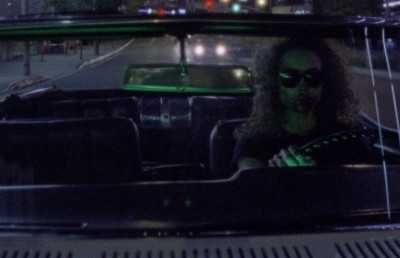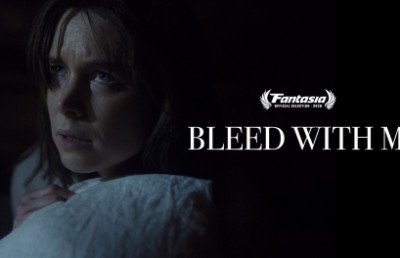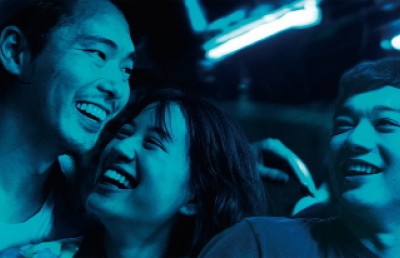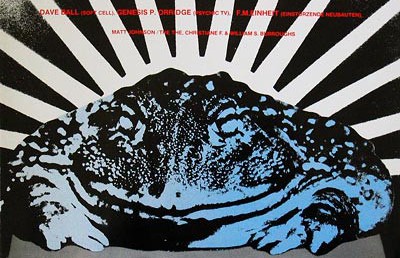Jennifer Reeder at Fantasia 2019: Knives and Skin
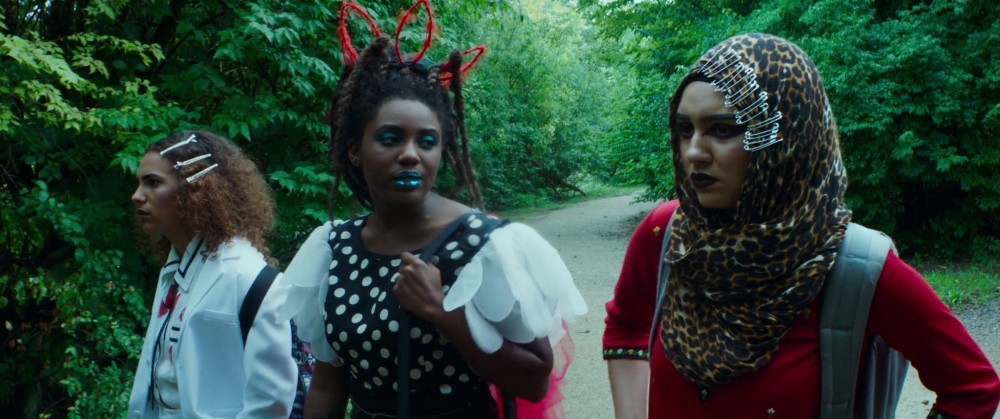
Knives and Skin is the feature film debut of the prolific short films art school director Jennifer Reeder. The film is hard describe. While essentially a coming-of-age film (a sub-genre which has produced some of the best popular cinema in the past ten or so years) Reeder comes to her first feature with a freedom that comes with a fine arts background and vast filmmaking experience (even if all as shorts). The result is a narrative subservient to characterisation and visual mood and tropes of the musical and Brechtian styled chorus comment on story and character as liberally as dialogue. You will be hard pressed to find even one review which does not compare the film to David Lynch and Twin Peaks, which seems fair enough but also insufficient to transmit the film’s spirit, which is far more melancholic, romantic and ultimately hopeful than Lynch. The similarity starts at the general narrative act that opens the film: a teenage girl from a small town community named Carolyn Harper (Raven Whitley) is found dead in the woods, an inexplicable event which sets those around the victim, family, friends, and acquaintances, into trauma mode (some more than others). Even less so than Lynch, Reeder is less interested in solving the murder (or death) than in examining the pulse of the town. Carolyn’s mother Lisa Harper (Marika Engelhart) is distraught. Carolyn’s jock boyfriend Andy Kitzmiller (Ty Olwin), who was out on a date with her on the night of her death, and a prime suspect, is both defensive and agitated. Andy’s sister Joanna Kitzmiller (Grace Smith), who is naturally programmed to dislike her brother’s jock status, sulks and broods alongside her two best friends, Charlotte Kurtich (Ireon Roach) and April Martinez (Aurora Real d Ausa). Andy and Joanna’s mother Lynn (Audrey Francis) has a severe case of eco-anxiety. While Granny Miriam Kitzmiller (Marilyn Dodds Frank) likes her weed a bit too much. And father Dan Kitzmiller is cheating on his unresponsive wife Lynn with neighbor Renee Darlington (Kate Arrington). Reeder pays great attention to the surface of the film, meaning the visual impact is strong. Emotional and at times overwhelming in its use of color and light. And when I use the word visual here I am implying sound as well, as Reeder’s use of original score by Nick Zinner and sourced 1980s and 1990s pop music forms a sensorial blanket with the images, weaving into its texture. Stylistically it heightens reality by establishing a color palette removed from reality, with most of the locations lit in gels and filters that produce a sensation above realism. The actions and situations are realistic –loss, grief, identity, sexual coming of age- but the color coding and interjection of song elevates the tone to cine-theatricalism. Where Lynch will often use moments of bizarre and surreal ruptures of reality, Reeder injects moments of magic realism and theatrical audience address to balance or subvert the desire to see plot move to a reasonable place. Some viewers may feel frustrated at some of these illogical moments, but the Fantasia audience went along for the whole ride and thoroughly enjoyed Knives and Skin.
Jennifer Reeder introduced the film to a packed 700+ seater house at the 2019 Fantasia Film Festival, and then stuck around for a lengthy Q&A after the screening, where she fielded questions from programmer Mitch Davis and the audience (while handing out a bunch of nifty, personalized gifts). The following is an edited transcription of the talk.
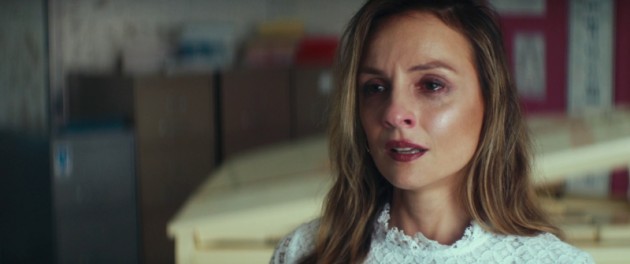
Lisa Suffering the Loss
Audience: Why did you name the film Knives and Skin?
Jennifer Reeder: Originally the title was “As with Knives and Skin”, which to me was a kind of truncated sentence. The first part is something like, what is the most vulnerable part of your life or what’s the most dangerous part of your life. Knives are dangerous, but also utilitarian. And skin is utilitarian and also really vulnerable. So this is a film really about survival and knives and skin are both about survival strategies.
Audience: I was thinking watching the film and the idea of the missing victim and how you play with the trope by not making the film only about solving the murder but what it means to the living.
JR: Absolutely. This is a genre film festival I love horror and genre films, but so many of them out there, at their core have this dead or missing woman, and as a feminist and a feminist filmmaker, that’s always been really problematic to me. So I wanted to make a feminist film that had a dead girl at its core. And it took me a little while to figure out how to make Carolyn Harper this willful body, and so she’s kind of a ghost, kind of a zombie. But no matter what, she doesn’t just die. She’s this body that moves herself around the town so that she can be found. And at least for me her death vibrates through the emotional veins and people in the town. She affects them. And so I wanted to take on the trope of the dead girl and still make a feminist film that has a dead girl in it.
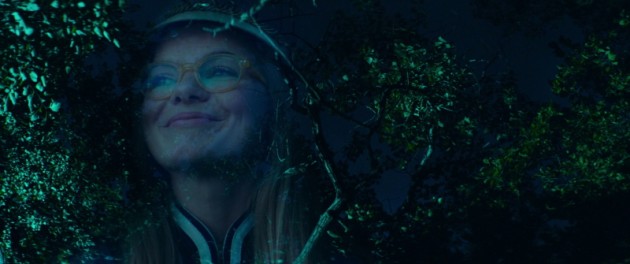
Carolyn Lives On
Mitch Davis: She’s established as this person in the town that almost has no identity and then she disappears and somehow becomes much more present and is being talked about and acknowledged. That felt like it was a strong allegorical point.
JR: Yeah. And I think that’s actually the moment where everyone just connected this film to Twin Peaks, which is not for me, the connector. A connector or an influence is more like River’s Edge. Which is also a 1980s film about a small town and a dead girl about the same age as Knives and Skin. But her disappearance is this trauma that vibrates within the town and turns everything over.
Audience: I was just wondering if you could talk a little bit about the singing choir aspect and how did that become a part of the narrative and why the 1980s music in particular?
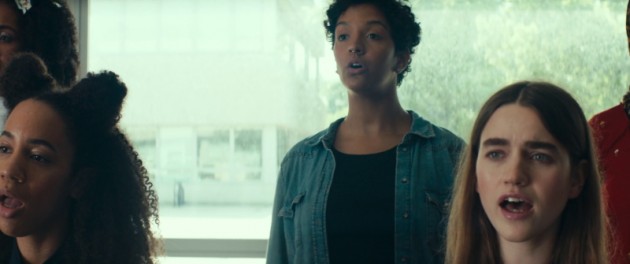
JR: We dismiss these 1980s pop music but if you hear “Our Lips are Sealed” by the Go-Go Girls as a lamentation it really becomes sad. All we have is each other to survive, we have to band together because the adults, the men are not protecting us, so all we have each other. So what started out as this poppy 80s anthem about female friendship becomes a battle cry.
Audience: Thank you for making the film queer as well. Where can we get the soundtrack.
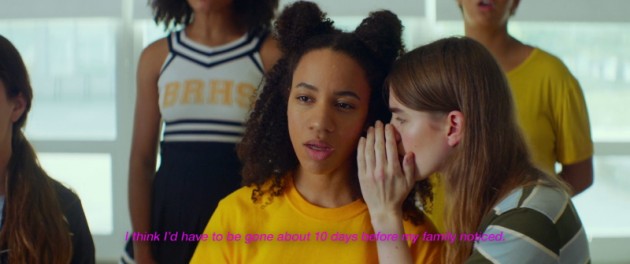
JR: It is in the works. UFO in Paris is doing the French distributing and is doing a French vinyl pressing. We have all the rights to the music. The soundtrack is coming out maybe even before the film will get a theatrical! And the score is by Nick Zinner of the Yeah Yeah Yeahs and I had him on a short leash during the short time. I am obsessed with his original score, which is beautiful and is the perfect emotional register.
Audience: Just a comment on the outfits the characters wore, which were all great.
JR: Yes. Yes, yes. Yes. I mean, you should all wear veils and capes and war paint and more eyeliner. I said that you were my favorite audience. My only criticism is, wear more eyeliner!
You should google Angela Davis and pray to her and your whole world will turn around. Joanna is a teacher in her teaching moments. But it’s, yeah, it’s beautiful world. Yoko Ono and Jane Adams, Sarah Lawrence College. I can go on and on. They’re all references. Like your life is different from this moment on.
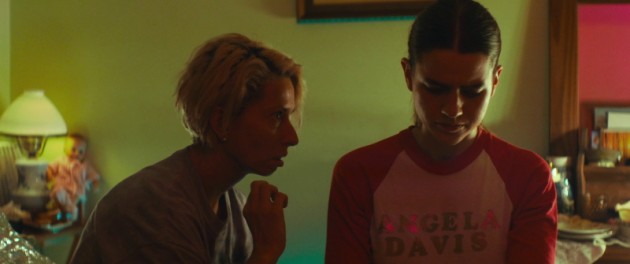
Angela Davis….go Google her!
Audience: Can you talk about your choice of the lighting and the direction of the lighting.
JR: Yeah I wanted this film in terms of the lighting to hover above reality. I wanted everyone to feel like you’re going into a very specific kind of world. This town has no name. It’s not identified as a specific place, nor even really a specific time. So I wanted everyone to go down this wormhole of a place. And so I had a long conversation with my DOP [Christopher Rejano, ed.] multiple times and the Gaffer who’s amazing. And I just said I want the whole thing to hover above reality. But even more so that I wanted the whole thing to be bathed in magenta and violet. And look, I know no one gender owns magenta. However, can we all agree that there’s something about magenta, violet that at least feels femme, you know? And so I wanted the whole thing just to feel like it was on display. Goofy vibrating girl power moments. And I wanting the lighting to be narrative content, or to feel like the lighting of the film was part of the magic that was propelling these girls forward. Everybody else was trying to block that forward movement.
Mitch Davis: Did you find also that those types of gels and lighting may have had an impact on the performance style of some of the younger actors?
JR: Absolutely, because we would be lighting a room and everyone else was in another room and then we would bring them in and they would be like, wow what is this little wormhole that I’ve entered? And I think that they would sort of settle their characters and settled into the zone of the film. Yes, I feel like it made a big difference.
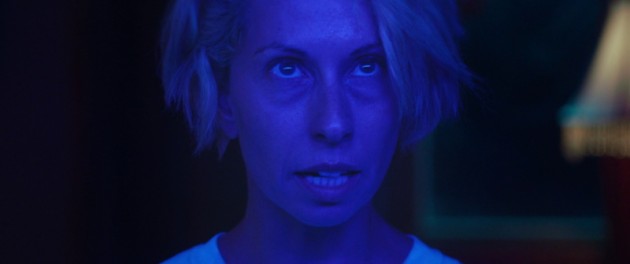
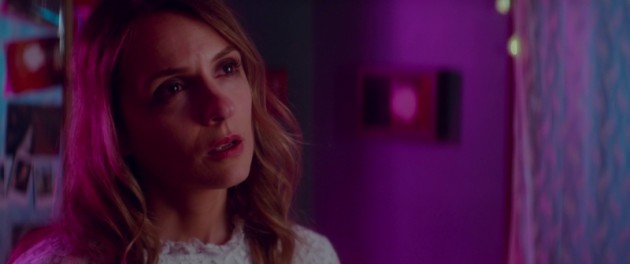
Wild Color Schemes
Audience: What was the production timeline?
JR: Twenty-five days shooting. I had made a bunch of short films, and I was thinking of making a feature film, which by the way, I just wanted to say, you know, short films are people too. And I don’t want anyone in this audience who is a filmmaker to think that there’s a feature length film or nothing. You know, I mean, when I say I made like 50 short films, I am not exaggerating. And yes we make short films to test out ideas. And we know that not every idea should be a long film, etcetera. Anyway, I made a bunch of short films. So I was like, okay, I’m going to just deal with this in a feature length way. And then when I was conceptualizing this film, I was hired to direct a film called Signature Move, a short which premiered in Quebec at the Image-Nation festival. And so I kind of put this on hold which ended up being great because I overhauled the entire script. So I shot Signature Move in the summer of 2016, three years ago. I made the other movie and then I came back to it, overhauled it, and then shot it last year. I took the summer of 2017 off, which is like unheard of for me really. But it was good for the project. And then we shot for 25 days last summer. We picture locked on let’s say November tenth of last year and let’s say November 11th, and then we had our world premiere. So it was like long and then quick.
Audience: Can you talk about the phobia that the Lynn character has?
JR: Sure. So there are a lot of people, not me, who have a kind of general environmental sensitivity. And they cover things in their house with tin foil to keep out certain electromagnetic waves. Some people will cover their whole house or whole walls, the ceiling with tin foil. I just wanted the audience not to know what the root of her psychosis or paranoia is. But I wanted to have this sense that she’s having a reaction, something environmental and covering the house with foil, gives her some, some wholeness but is rooted in reality.
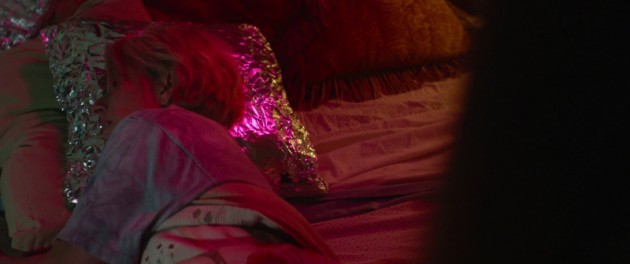
Mitch Davis: You’ve said that you see coming of age as a lifelong process and I was really moved by that statement. This is one of the most empowering coming of age films that I’ve ever seen. One of the most unconventional. Do you want to discuss your approach about writing the teenage characters, the adults almost as teenage characters themselves?
JR: So this is again an element of my shorts. If you are all curious, which you should all be. My shorts A Million Miles Away (2014) and Blood Below the Skin (2015) are two films that were at Sundance and Berlin. And together they are a little bit of an appetizer to this film. And they deal directly with this idea of an adult coming of age. And I think it’s true. I mean, we get to come of age once, really, when you really are still a child. And then if you come of age again, it’s called a crisis. You know, just seemingly problematic. I love “difficult women,” in particular, I love “difficult mothers” who are getting it wrong and then suddenly we have an empathy or sympathy for them. And I love showing that young people have deep agency. I think that we don’t credit young people enough for how smart they are and how connected and engaged they are. We do so much verbally and otherwise to disconnect young people from their agency. I want my films to say actually, you know, the young are the sages. And we can learn a lot from young people and you could learn a lot from just allowing yourself to evolve. Again, unapologetically.
Audience: Just because you mentioned it, can you talk about the film’s relationship, if any, to Twin Peaks and David Lynch?
JR: I can tell you that in the nineties I watched it once. I haven’t even watched the second season and, you know, I mean, I am not obsessed with Twin Peaks, that’s the funny thing. A lot of even very good critical writing compares Knives and Skin directly to Twin Peaks. David Lynch, for sure, in general, is deeply influential. However, I actually feel much more influenced by Blue Velvet, by Eraserhead, by his shorts, by Lost Highway, even Inland Empire. So Twin Peaks was something that was, ok that’s cool. Knives and Skin is going to play the Portland Film Festival in Oregon, which has a Twin Peaks Tour and of course people ask me, ‘do you want to do it’, and I’m like, absolutely not. I want to be the first person who went to Oregon and did not do the tour…..but I’m going to do it. But I’m going to be grumpy the entire time! I think that David Lynch as a whole is deeply influential. I love how he has dealt with small-town America as a portal to the fourth dimension. I love his stiff, awkward dialogue and I love that his characters shift. I love the way he uses light and darkness. I love all of that stuff. But when I was thinking about Carolyn Harper, I was not thinking about Laura Palmer
But at the same time, it’s, it’s, I mean, there can be a lot weirder, more off-putting comparisons. I don’t mind the Twin Peaks connection but River’s Edge, you know, if anyone is curious about other films from the eighties and nineties that have dead bodies. River’s Edge is one to look out for.
Mitch: There is a bit of a Tim Hunter vibe.
JR: Yeah. Yeah. And also I think that this is more John Waters then John Hughes. Anyway, like my influences when I was in Grad school was deeply John Waters-based in terms of the kind of transgression and the abject.
Mitch Davis: John Waters wouldn’t be capable of this kind of melancholy, and I have endless respect for him.
Audience: You mentioned problematic mothers and coming-of-age movies and your mother reminded me of another great problematic mother, Mimi Rogers in Ginger Snaps. I’d like to ask you about your use of those magic realist moments, like the neon green in Andy’s blood when he is cut by Carolyn in the opening and Carolyn’s green glowing glasses.
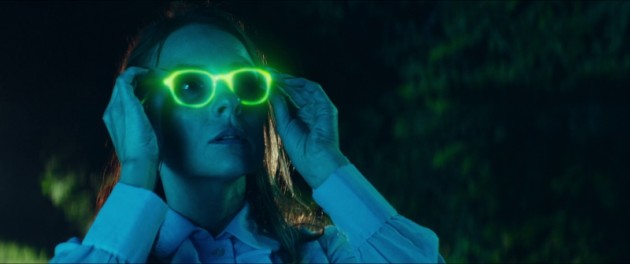
Magic Realism
JR: Yeah. I mean I use that again in some of my shorts and I feel that it works and use it to suggest that, you know, as awful as this concrete world feels sometimes I want us to have hope. Hope that there is a parallel universe where your favorite tiger shirt will give you advice. I want inanimate objects in our life to have aura. And I think that a lot of people do believe that, but these are kinda like normal people who, at the end of the day kind of need, the glasses of their dead daughter or their favorite tiger shirt to really ground them. And I think you can only do that in cinema. I did not only go to film school I went to Art school. So actually I feel somehow I get to take a lot of license with how I tell the story as it’s coming out of an art school context rather than a film school context.
I have a history of a much more experimental work and a history of making films or making a moving image work that lived in a gallery and museum. Were you can do anything you want. And so with this film, this is exactly the film that I set out to make. So I somehow convinced my producers to let me do exactly the film that I that I wanted to make. I’ve made a bunch of shorts that had been vetted by many people. And so then they said, okay, we will finance your feature film. And I said, here’s what I want to do, and here’s the lens I want and there’s this lighting I want. And there were moments where the foot came down and I would just say yes or no if it’s No, I’ll deal with it. But if it’s yes, then I don’t want to care about the money. So I made exactly the film I wanted to make.
I’m here also right now in Montreal during the Frontiers market pitching a new project. And having made this has just given me motivation to say I’m not doing another film or a follow-up film that is any less ambitious or personal. I feel grounded in my stubbornness to make another film exactly as the one I want to make.
Mitch Davis: So good to hear.
Audience: There’s something that I don’t see very often. And that is, many, many layers of femininity, many layers of womanhood. But also you do not forget the younger generation when you have a young girl growing up, all of them coming of age. Moms were going to engage as well in their own way. And once again what really gives me joy was characters that possibly in other contexts would usually become readout tropes or jokes, were not in your film. And for instance, the grandmother, she could have easily become a joke and she does not, and she also dropped with them. Yeah, mothers could easily become a joke. And they’re positioning in the film was really important. And they did come of age, the three girls, especially the three girls, they did not become jokes. Each had their own agency as well. And it was also very important that they work it out. And it was wonderful to see all of these different representation and they all got the space to be themselves and to play off of each other. It wasn’t all about competition. There is so much variety. At the same time you were not trying to shoehorn everything in. And I think that it reminds me of two films that are very much unlike your film. One of them would be Boyhood. Boyhood follows one boy who, how shall we put it, shows many different aspects of being a boy and it wasn’t always what we saw or expected. We live with his reactions. And the other one would be Daughters of the Dust.
JR: Don’t make me cry! That’s a formative moment, and Julie Dash. I saw Daughters of the Dust at a time when I was in film school and saw it in a theatre. And knowing that a woman directed that film, I was like, oh, I can do this. Yeah. That’s a brilliant reference about female family, about friendship. And for me it was very, very, very transformative. I think, yes.
So as a sort of closing … are there any moms out here?
Mitch Davis: (After no one reacts) There are non-verbal moms tonight!
JR: I’m tired, I’m a mom, I’m fine, I came here to take a nap. So I am a mother. I have three sons. Very ironically, three young sons. I will eventually make a film about boys and boyhood. But even before I had children, I have a tremendously awesome mother who was never dysfunctional. She’s 88 and she is still deeply engaged and more than active. And under this horrendous Trump administration she has this huge sign in her front yard in central Ohio that says, “Everyone is Welcome here” and this sign is in English and Spanish and Arabic, beautiful, you know? And my grandmother went to Oberlin, which is one of or the first colleges in the United States to admit women and she was a Suffragette. I mean, I come from a legacy of a powerful moms. But I also recognize that, you know, like motherhood is complicated. But moms are not these wet blankets that so many films portray mothers as, these wet blankets, or at the very least, not sexual. I can go on and on. And at the same time, I think there’s so many films, in my shorts and this one also, where I want to dispel the myth of the mean girl. You know, I mean, there’s that scene where Joanna says, or her friend Jesse says, like you’re kinda mean too, and she says, ‘that’s all we have.’ I think that we live in a culture that calls young girls and adult women, mean or, or bitchy or bitches, which I think is really hateful term even though I gave out buttons that say ‘bitchy’. But I just think that there are survival strategies for not just women, but people in our group, queer people, you know, I think we have to sort of embrace and recognize our coping mechanisms. And I wanted to make a film that was empowering and celebrating friendships and celebrating families. That had some darkness. But at the same time, I’m hoping that you’ll come away from this film knowing that, in this imaginary world that is Knives and Skin, that there is hope and beauty because I do believe in this weird world that we live in that there is hope and beauty. Thank you so much for joining us.



